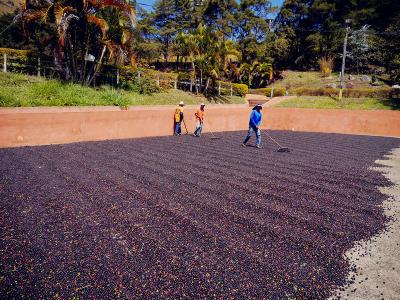Brief introduction of taste treatment method for description of species and flavor in structural diagram of coffee beans
Coffee bean structure diagram type flavor description taste processing method introduction
Another method is washing, that is, the harvested fruit is placed in a flowing tank, after removing the floating fruit, the skin and pulp are removed by a pulp remover. Then put it in the sink and remove the floating pulp. After that, move into the fermentation tank, soak for half a day to a day, and then dissolve the colloid on the surface of the fermented coffee beans. After washing with water, drying for several days, drying with a machine, and finally removing the endocarp with a huller, it becomes a raw coffee bean that can be used as a commodity.
Washable coffee beans have a better color and less impurities. Colombia, Mexico, Guatemala and other countries about 70% of the production of this method.
Sometimes in the fermentation process, if not handled properly, it may emit fermentation odor and its characteristic sour taste; but if handled properly, all kinds of beans can emit their unique coffee aroma.
Coffee was planted in large numbers by Arabs in the twelfth and third centuries, and the world's first coffee house was born in Damascus (1530) in the Middle East in the sixteenth century. Within a few short years, more than two hundred cities throughout the empire, from ancient Constantinople to the Caucasus, from the Persian Gulf to Budapest, had varying numbers of coffee shops, and the roads that connected them through the desert wilderness were filled with mobile coffee tents to serve the endless stream of merchants and armies. Coffee also spread to Europe in the same century, when coffee was brought to Western countries with the Turks in Austria

Important Notice :
前街咖啡 FrontStreet Coffee has moved to new addredd:
FrontStreet Coffee Address: 315,Donghua East Road,GuangZhou
Tel:020 38364473
- Prev

The thickness of coffee bean grinding can be selected-Starbucks coffee bean grinding grade
Coffee bean mill can choose the fineness-Starbucks coffee bean mill grade ① friction heat suppression to a minimum. (the aroma will be dispersed due to fever) whether the size of ② particles is uniform or not. (if the particles are uneven, the concentration will be uneven.) taking this as a consideration, if you are a household mill, you should rotate gently and be careful not to produce friction heat as much as possible.
- Next

How long is the shelf life of ripe coffee beans?
How long is the shelf life of coffee cooked beans? the shelf life mentioned in the packaging of general coffee means that the aroma components of coffee can be retained to a certain extent. Not when the coffee may go bad. Because coffee is different from ordinary food, its humidity is very low and it is not easy to deteriorate. After making coffee, the waste coffee grounds grow hairy, just because the coffee grounds get wet.
Related
- Guji coffee producing area of Guji, Ethiopia: Humbela, Shakiso, Wulaga
- What is the most expensive variety of Qiloso in BOP multi-variety group?
- How to store the coffee beans bought home?
- Why are Yemeni coffee beans so rare now?
- Ethiopian Sidamo all Red Fruit Sun Sun Santa Vini Coffee beans
- SOE is mostly sour? What does it mean? Is it a single bean? what's the difference between it and Italian blending?
- Is Italian coffee beans suitable for making hand-brewed coffee?
- How to choose coffee beans when making cold coffee? What kind of coffee beans are suitable for making cold coffee?
- Just entered the pit to make coffee, what kind of coffee beans should be chosen?
- Can only Japan buy real Blue Mountain Coffee? What are authentic Jamaican Blue Mountain coffee beans?

